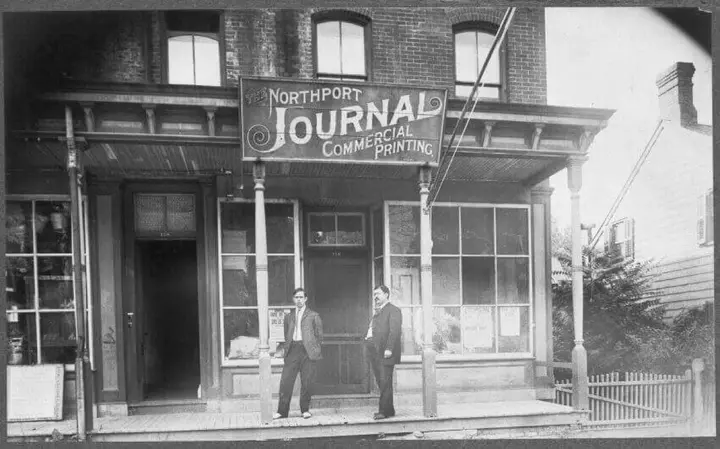Looking back at the Northport Journal over time

As excited as we are to launch the Northport Journal, this isn’t the paper’s first rodeo.
In fact, the Journal predates most of the other local and regional newspapers you’ve known for years. Newsday. The Observer. Even the New York Daily News. They’re all younger than we are.
The original Northport Journal started in 1874, when noted architect Benjamin Robbins founded it as an effort to provide a voice for what was then a growing community. From there, according to Terry Reid, curator at the Northport Historical Society, the paper operated continuously for more than 100 years until it stopped printing for a while at some point in the 1980s.
“It definitely had staying power,” Reid said recently of the original Journal. “It speaks to how close-knit and special Northport is. Back then, everybody knew everybody. It was a small town. Families married into other families. Everybody was intertwined. The Journal captured that spirit of Northport, the spirit of being good neighbors. It became the paper of record for our little community and stayed that way for a long, long time.”
That original Journal sold for 5 cents per copy. Early editions were eight pages long. The front page often featured stagecoach schedules, as well as a directory of churches and lists of Suffolk County attorneys.
The original office was at 154 Main Street, within the Moy Laundry building. That location is currently Penny & Cooper.
The paper changed hands a few times over the course of the late 1800s and early 1900s. Then, in 1922, it fell into the hands of the woman who made the Journal an institution. Her name was Marion Brett.
Technically the Journal was owned by Marion’s husband, John Brett. Old documents indicate John was a prominent guy in the community at the time, but the printing press kept breaking, and John couldn’t exactly figure out how to make any money on the Journal. Then he died suddenly. Marion took over. And the rest, they say, is history.
Marion was shrewd. Instead of wasting time and money trying to fix the old press, she contracted with another local paper to print the Journal there. This saved big bucks. Eventually, those savings turned into profits.
Using the paper as her only means of income, Marion ran the Journal for more than 40 years. She became a fixture at every Village Board meeting. She attended every Board of Education meeting. For most of these years, she had an editorial column that she always started with the words, “Dear Folks.” Everybody in town had to read Marion’s opinion before they formulated their own.
Marion recorded every major announcement around town. Weddings. Deaths. Births. Her words enabled community members to stay connected with their neighbors and air their differences in a civil manner. When the community was embroiled in the controversial (and environmentally dangerous) sand mining industry (this is how we got Steers Pit, people), Marion was one of the most outspoken critics.
It’s not surprising that when Marion died, so too did the original Journal. After about a decade of dormancy, the paper restarted in the 1990s as a historical paper. The Northport Historical Society’s own George Wallace wrote articles for the Journal at that time. In the mid-1990s the paper became part of The Long Islander newspaper chain. Called “The Long Islander’s Northport Journal,” it was published as an arts and history journal until 2012 when the name stopped being used altogether. Once again, the paper was shuttered. Until now.
Current Journal staff members see themselves as carrying the torch that Marion Brett first lit.
Reid, the historian, said the best way to do this is to emphasize a feeling of neighborliness, a facts-first mentality.
“Just reporting on the major events so everything is preserved for posterity is important,” she said. “Any way the new Journal can become personal with the community, any way the new paper can keep the focus on people and community, it will be following in the footsteps of the original.”
As our new staff embarks on a new journey with an iconic legacy, it’s always good to reconnect with the past. For a look at a digital archive of original issues of the Northport Journal, click here.

154-166 Main Street. Now called Masonic Temple. Benjamin T. Robbins, builder, stands in front. Store of Ulysses N. Robbins, (his son) Plumbing and Heating, is in center bay. Offices of Northport Journal, also owned by B. T. Robbins. Photo courtesy of Northport Historical Society.
Don’t miss a story
Get the latest news delivered to your inbox.







